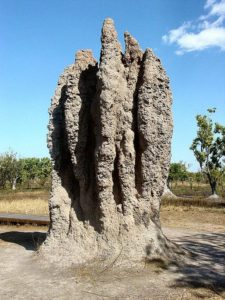 Termites are the oldest social animals, starting elaborate societies 200 million years ago—50 million years before ants and bees. They began agriculture with fungus farming before ants. Like ants and bees (described in previous posts Remarkable Bee Brain and Ant Intelligence Update), termites exhibit remarkable individual and group intelligence. The amazing behavior of termites is described in this termite intelligence update.
Termites are the oldest social animals, starting elaborate societies 200 million years ago—50 million years before ants and bees. They began agriculture with fungus farming before ants. Like ants and bees (described in previous posts Remarkable Bee Brain and Ant Intelligence Update), termites exhibit remarkable individual and group intelligence. The amazing behavior of termites is described in this termite intelligence update.
Insect intelligence has been described in previous posts. We have seen that individual bees can solve difficult mathematical problems—for instance, when sizing up the most efficient route to a flower. They, also, use symbolic language and abstract concepts; remember flowers’ exact locations and qualities for miles including angles of the sun; self medicate the hive; and build the advanced honeycomb structures. Ants show great individual intelligence, learning new ways to navigate and integrating these with multiple other techniques, as well as learning from elders. Fruit flies pay selective attention to new objects in their environment. A recent study showed that ladybugs, a beetle also called ladybirds, judge the plant quality that an aphid will like and wait for their food on those particular plants.
Although there has been less intense study of the intelligence of individual termites compared with ants and bees, the award for most advanced engineering must go to the termite.
Termite history
 Of the 3000 species of termites, only a very small number eat human dwellings. Termites are the first animal societies on earth. They ate bones in the time of the dinosaurs. They have had a symbiotic relationship with many different microbes since 150 million years ago. Termites are an example of the simultaneous evolution of an animal with multiple microbes for the purpose of eating the hard cell wall of woody plants. While ants have the greatest insect biomass (more than all humans), in the tropics, termites have 100 tines the biomass of ants.
Of the 3000 species of termites, only a very small number eat human dwellings. Termites are the first animal societies on earth. They ate bones in the time of the dinosaurs. They have had a symbiotic relationship with many different microbes since 150 million years ago. Termites are an example of the simultaneous evolution of an animal with multiple microbes for the purpose of eating the hard cell wall of woody plants. While ants have the greatest insect biomass (more than all humans), in the tropics, termites have 100 tines the biomass of ants.
Termites live in many different environments and, because of their constant activity, produce dramatic positive effects in each region’s ecosystem. They live in deserts, savannas, tropical rain forests and temperate woods. They are the greatest known engineers of the soil. Termites’ digging creates avenues for the moisture to penetrate deeply. They mix many materials together, which is vital for keeping nutrients and avoiding soil erosion. The substances that they mix include tiny pieces of leaves and plants; various substances from the earth including clay, stones and sand; their own biological material when they die such as skeletons; and other pieces of animals.
 Among all animals, termites surpass even the beaver, in altering local and large-scale environments. They allow animals to survive in very arid regions even at night, in dry seasons and during a drought.
Among all animals, termites surpass even the beaver, in altering local and large-scale environments. They allow animals to survive in very arid regions even at night, in dry seasons and during a drought.
Termites are fragile creatures. They must stay moist at all times, so they cover their trails with dirt and feces. They also make travelling tubes to protect themselves from ants and from the dry air. This is why termites enjoy living in the walls of people’s houses. Termites live in large groups which makes them extremely hard to get rid of if you do begin to get an infestation of them. Luckily, pest control experts (that can be found on websites like https://www.pestcontrolexperts.com/all-services/termite-control/) are able to help homeowners get rid of termites, quickly and efficiently.
Termites often feed each other from the mouth or the anus, especially soldier termites whose jaw grows so large they cannot feed themselves. The workers, who eat tasty wood, have microbes in their gut that help them digest the cellulose Termites, also, have a special bacterium that fixes nitrogen from the air, which they use as a fertilizer.
Effects on Regional Ecology
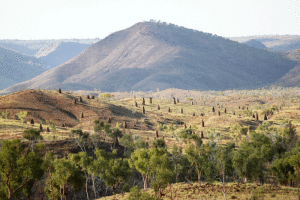 In areas of dryness, the well-spaced termite mounds make oases of plants, keeping the desert from expanding and greatly helping the local animals. Termites fertilize their fungus farms in tunnels with vegetation, which includes phosphorus, nitrogen and other organic materials. When they add clay they make the soil harder for sturdy tunnels. In areas where it is too difficult to dig, they add sand. Plants grow better in both scenarios. Acacia trees that are closer to the mounds have more fruit from increased nitrogen. Even ants, spiders, flying insects and geckos grow larger when they are near the termite mounds. In these regions cultivated farmlands do not have the advantages of the termites.
In areas of dryness, the well-spaced termite mounds make oases of plants, keeping the desert from expanding and greatly helping the local animals. Termites fertilize their fungus farms in tunnels with vegetation, which includes phosphorus, nitrogen and other organic materials. When they add clay they make the soil harder for sturdy tunnels. In areas where it is too difficult to dig, they add sand. Plants grow better in both scenarios. Acacia trees that are closer to the mounds have more fruit from increased nitrogen. Even ants, spiders, flying insects and geckos grow larger when they are near the termite mounds. In these regions cultivated farmlands do not have the advantages of the termites.
The tropics and subtropics have the most termites, where they are 95% of the insect biomass. In the African savannah it is a greater mass than grazing animals. While only a tiny percent eat wood houses in the US, it still costs billions of dollars of damage.
Termite Societies
 Termites divide labor and take care of young together. The infant larvae moults into a worker termite. Some of these moult again into soldiers and a third time to become a reproductive member. Labor is divided in colonies of hundreds and millions.
Termites divide labor and take care of young together. The infant larvae moults into a worker termite. Some of these moult again into soldiers and a third time to become a reproductive member. Labor is divided in colonies of hundreds and millions.
Termites can signal each other but these signals are not well known. Kings and queens sometimes fly away and start a new nest. Queens can live for decades. While making a fantastic amount of eggs, they are fertilized actively by the king throughout their lives together. This is different from the ant queens where they are only fertilized once for all of their eggs. In some colonies only the king and queen have eyes; some rare workers and soldiers have eyes, but most don’t. If bees/wasps are in their natural habitat, then there isn’t much you can do about getting rid of them. But if they are disrupting your personal space, such as forming a nest in your garden, then the assistance of a pest control olathe ks (or one closer to where you live) could come in handy to help eliminate this issue.
Researchers created a desperate situation for a group of termites, requiring that they flee. Unlike other creatures (including bees and ants), termites are very calm and methodical in their escape. When panicked, other creatures run around, banging into each other. Termites, on the other hand, move in orderly fashion related to their social hierarchy. Workers form a single line behind a leader and march. They kept moving around looking for a way out. When one of those in the line falls, the others calmly wait until he stands up. Fighters stand on the side of the column preparing to fight an enemy by snapping their jaws.
Like ants, termites, also, exhibit altruism in helping other comrades. Please see post Ant Intelligence Update for the details of ant altruism.
Termite Class System
Along with other societal animals, termites employ a division of labor. They have a large queen who lays all of the eggs. Termites are 50% males and 50% females, unlike ants that are mostly sterile clones of a daughter.
Termite societies consist of four different classes that need each other to survive. The elite class of king and queen produce the rest of the colony—the queen spends her life producing eggs. Supplementary reproductive termites can conceive if there is a problem with the queen. Workers are the largest group and provide food, build nests and take care of the children. Soldiers defend the colony from predators.
 The workers only live underground and most don’t have eyes. Workers find food for all of the others in the colony. They eat dead wood, transforming it into a liquid and then regurgitate it at the colony. They break down the wood with the help of microbes. The microbes are able to digest cellulose in woody plants, which is termites’ main source of food. The workers build the complex mound structures, which are maintained at particular temperatures and oxygen and carbon dioxide amounts, despite the outside environment. They are the master engineers, maintaining the atmosphere in the mound and repairing any breaks.
The workers only live underground and most don’t have eyes. Workers find food for all of the others in the colony. They eat dead wood, transforming it into a liquid and then regurgitate it at the colony. They break down the wood with the help of microbes. The microbes are able to digest cellulose in woody plants, which is termites’ main source of food. The workers build the complex mound structures, which are maintained at particular temperatures and oxygen and carbon dioxide amounts, despite the outside environment. They are the master engineers, maintaining the atmosphere in the mound and repairing any breaks.
The workers, also, care for the larvae and the young. The queen lays a series of eggs and then the workers bring the larvae into a special room in the mound. They turn them over and examine them for any diseases from parasites.
 Soldiers have very strong heads that are plated with armor. They have a much stronger skeleton and very strong jaws with mandibles that bite. Because of the size of the jaws, they need to be fed by others. They have sharp teeth and some have hooks. They, also, are able to secrete a poison from their salivary glands that are spread by their jaws when they bite enemies; it is both toxic and is like glue sticking enemies together
Soldiers have very strong heads that are plated with armor. They have a much stronger skeleton and very strong jaws with mandibles that bite. Because of the size of the jaws, they need to be fed by others. They have sharp teeth and some have hooks. They, also, are able to secrete a poison from their salivary glands that are spread by their jaws when they bite enemies; it is both toxic and is like glue sticking enemies together
The major enemies are ants, but, also, reptiles and some mammals. Soldiers mainly use their antennae for direction. They make a warning sound to the colony by beating their heads on the ground. Ants are much better fighters and more organized into armies. The solitary termite soldier, with backup lined up behind, often defends a break in the mound the size of its large head. This one termite fights the onslaught of the ant army alone until the break is repaired behind him. He fights on till death. If he is killed before the break is fixed, then another steps up to fight and continues to block the hole in the mound. Some soldiers can explode spewing sticky material on the ants (the original suicide bomber).
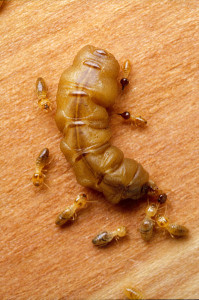 The queen lives deep inside the mound and is protected by many soldiers and fed by workers. The king is always by her side. The queen can grow hundreds of times larger when pregnant, even to several inches, and becomes unable to move or feed herself. By age three she produces thousands of eggs every day. One species can lay an egg every second, which is 80,000 per day.
The queen lives deep inside the mound and is protected by many soldiers and fed by workers. The king is always by her side. The queen can grow hundreds of times larger when pregnant, even to several inches, and becomes unable to move or feed herself. By age three she produces thousands of eggs every day. One species can lay an egg every second, which is 80,000 per day.
A subclass of the king and queen is called secondary reproductives. These are termites who can reproduce, but usually don’t. They wait to substitute for the king and queen if anything happens to them. When a queen dies, several of these secondary reproductives are called upon.
Termite Nests, Mounds and Skyscrapers
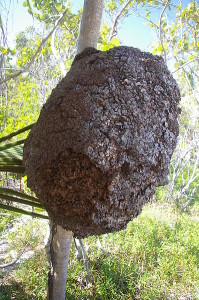 Termites live in many different regions and have different types of homes. One type builds large nests in trees. The most famous type build mounds, in Africa, Australia and elsewhere.
Termites live in many different regions and have different types of homes. One type builds large nests in trees. The most famous type build mounds, in Africa, Australia and elsewhere.
The mound is an engineering marvel to prevent sensitive termites from becoming dehydrated and to maintain their elaborate society. Even in desert-like conditions, termites require 90 percent humidity and the protection of underground tunnels. The mound structure is a massive complex of corridors, compartments and tunnels designed to circulate air in just the right way, that is, to eliminate CO2 and water and take in oxygen with just the right humidity. The termites use wind, solar energy, north-south magnetic positioning, and extremely complex engineering to survive.
Although it takes years to build these mounds, if damaged by large animals, the mound can be repaired within months. The termites use secreted substances, as well as their feces, to give the mounds strength and stability. It, also, helps the soil nearby. During the process of repair, soldier termites defend the workers. Since termites have almost no vision, the workers each carry a piece of dirt with saliva on it. It is thought that other termites then use the smell of the saliva-covered dirt to signal the correct place to rebuild the complex structure. But, in fact, it is not known how individual termites can help build such complex structures.
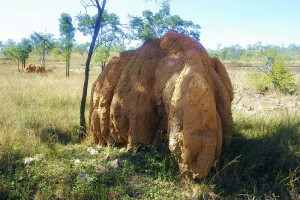
Mounds can be thirty feet high and 80 across in parts of Africa. These large mounds can house tens of millions of termites. The mounds are cool in the day and warm at night, attracting and benefitting even large animals like antelopes. If a termite were the size of a human, such a structure would be taller than most skyscrapers.
The nest is a small part of this massive structure—only three feet in diameter near ground level, with special rooms for the queen and the nurseries. In addition, they build rooms in the mound to grow fungus, which is farmed by the termites. The excrement of the termites fertilizes these mushroom gardens, which helps feed several million termites living in these colonies.
Changes in general outside temperature in day and night help the flow of air inside. This is similar to a very slow breath in and out. Termites’ breath out carbon dioxide, which accumulates in the tunnels and then is breathed out of the mound. Previously, the tunnels were assumed to, only, eliminate the buildup of heat.
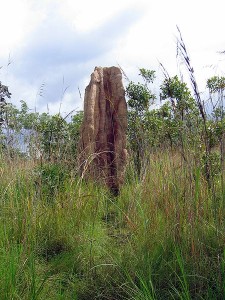 In the hot day, the air in the tunnels heats up and rises in the outer regions of tunnels. At night, the air outside is cooled and inside falls down a major central trunk of the tunnel (called the chimney). This expels CO2. The ingenious structure itself creates the breathing in and out.
In the hot day, the air in the tunnels heats up and rises in the outer regions of tunnels. At night, the air outside is cooled and inside falls down a major central trunk of the tunnel (called the chimney). This expels CO2. The ingenious structure itself creates the breathing in and out.
Termite mounds, by providing moisture in very dry regions, work against the spread of deserts. This occurs because the mounds have many tunnels that allow water and nutrients to get into the soil. These areas can maintain vegetation, including seeds, with much less rainfall. There is much more vegetation right near the mounds. What was found is that termites create a pattern over a wide region. They become a center for other animals to graze and find prey.
Symbiotic bacteria and protozoa
 Termites are an example of the simultaneous evolution of an animal and multiple different microbe species. The various species of termites have evolved different types of microbes to break up the very hard combination of lignin and cellulose that make up the cell walls of woody plants. Some of the microbes, also, fix nitrogen. The nutrition of termites is highly dependent on the mix of microbe types and different gut designs. These microbes include flagellates, protozoa, archaea and bacteria. This symbiotic relationship allows termites to benefit from the microbes’ digestion of wood, dirt, lichens, and dung, which termites cannot eat by themselves.
Termites are an example of the simultaneous evolution of an animal and multiple different microbe species. The various species of termites have evolved different types of microbes to break up the very hard combination of lignin and cellulose that make up the cell walls of woody plants. Some of the microbes, also, fix nitrogen. The nutrition of termites is highly dependent on the mix of microbe types and different gut designs. These microbes include flagellates, protozoa, archaea and bacteria. This symbiotic relationship allows termites to benefit from the microbes’ digestion of wood, dirt, lichens, and dung, which termites cannot eat by themselves.
The fact that microbes in termites can digest lignin and cellulose makes them important in the larger ecology of carbon management on the earth. Being able to break down plant fibers that are difficult to digest allows for many different events. It helps the termites get nutrition that couldn’t otherwise. It creates acetate and methane as byproducts of the fermentation. It is a critical part of the carbon and hydrogen cycles. The pieces from the digestion that are excreted become a long-lasting reservoir of organic material for the forest.

Lignin cellulose is the material for the cell walls in woody plants and trees. The termite microbes rapidly mineralize the lignocellulose that is otherwise very resistant to enzymes. It is a very efficient process.
Termites have multiple complex digestion processes. They utilize between a few types of microbes up to 20 different species for different aspects of this digestion process. Also, their gut has evolved along with each process to form different compartments with different environments.
Microbe cells can be quite large with many flagella allowing them to eat larger pieces of wood and preventing them from being washed out. Hydrogen is a main byproduct and the microbes have special organelles (hydrogenosomes) that produce hydrogen. These microbes are like mitochondria but make less ATP. They are either mobile or attached to the gut.
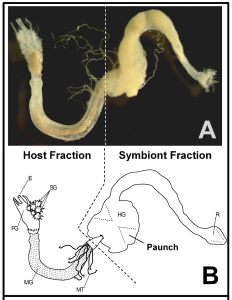
Some termites form a large pouch in the hindgut, where special microbes can live. Increased alkalinity helps and is at the highest level seen in any organism. Dilated compartments have no oxygen in the process.
There are differences in soil feeding and in wood feeding species as well as higher and lower termite species with very different guts and very different microbes. The higher type has very special compartments and is very elongated to aid in the digestion process. Many kinds of diet and different kinds of microbes occur in different species.
Spirochetes are the most common in lower termites. Other microbes can be attached to the wall. Lower termites can only eat wood. Higher termites have evolved the ability to eat dry grass, plant little, dung from herbivores and other organic material.
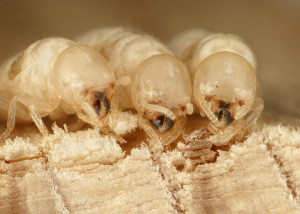 The termites and microbes work together. The termite jaws break up wood into small pieces that are eaten and mixed with enzymes from salivary glands. Glucose is absorbed from the gut. The partially eaten wood goes to the pouch. The flagellates take in the material and break up the polysaccharides with enzymes. These enzymes are secreted into vacuoles in the flagellates. The products are short chain fatty acids that are absorbed into the termite. The remaining lignin is excreted in the feces. In higher termites, bacteria replaced the flagellates.
The termites and microbes work together. The termite jaws break up wood into small pieces that are eaten and mixed with enzymes from salivary glands. Glucose is absorbed from the gut. The partially eaten wood goes to the pouch. The flagellates take in the material and break up the polysaccharides with enzymes. These enzymes are secreted into vacuoles in the flagellates. The products are short chain fatty acids that are absorbed into the termite. The remaining lignin is excreted in the feces. In higher termites, bacteria replaced the flagellates.
Some species use fungus byproducts to help with the digestion. Most do not. Workers find partially digested plant litter with fungus spores in the gut. Feces with lignin and cellulose fertilize the fungus garden.
Lignocellulose Digestion
 Lignocellulose is the very hard material that makes all wooded plants strong. It strengthens the cell wall of all trees, bushes and grasses. It is made of carbohydrate polymers of cellulose and aromatic polymers of lignin. Sugars of five and six carbons are bound to lignin. To form lignin, amino acid phenylalanine becomes a monolignol and then a sugar is attached, which makes it more water soluble to carry it through the membranes. Then large molecules are polymerized using many monolignols.
Lignocellulose is the very hard material that makes all wooded plants strong. It strengthens the cell wall of all trees, bushes and grasses. It is made of carbohydrate polymers of cellulose and aromatic polymers of lignin. Sugars of five and six carbons are bound to lignin. To form lignin, amino acid phenylalanine becomes a monolignol and then a sugar is attached, which makes it more water soluble to carry it through the membranes. Then large molecules are polymerized using many monolignols.
Lignin is critical to keep water out of the plant cell wall and allows the plant vessels to move water without seeping into cells. Because lignin is so hard to break down, it has significant effects on the cycling of carbon in the forests. It decomposes very slowly, providing long lasting nourishment to the environment. Several fungus—brown rot, soft rot, and white rot—can break down lignin in the woods and, also, in buildings and fences.
Fungus degradation of lignin uses a powerful set of reactions using iron. This Fenton reaction oxidizes lignin forming hydroxyl radicals. These don’t use the other enzymes at all. For this an acidic condition is necessary.
The termite’s strong jaws, also, break up lignocellulose. The hindgut compartment is a unique environment, unlike any other known biological system. It takes wood particles and makes short fatty acids, which are digested by the termite. In the lower termites, this is from flagellates take cellulose to hydrogen and CO2 and lactate.
Nitrogen Fixation
Soil feeding termites mineralize nitrogen from decayed organic material of plants and animals. This nitrogen is taken from peptides components reduced to N2 and ammonia and is at a high level in guts. The termite eats the carbon. These termites have very different microbes. The nitrogen is then oxidized and released as N2O.. Nitrogen taken from wood digestion is voided in feces. Flagellates fix nitrogen, assimilate ammonia and synthesize amino acids and vitamins.
Fungal Farming
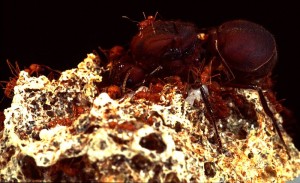
Deep inside the large mounds, termites farm fungus (like ants), which they use as food and to gather enzymes that, also, help them to break down foods they cannot eat by themselves. The fungus, in return, gets a place to live that has great ventilation and is filled with water and nutrients. It is, also, safe from other predators.
Some termites started cultivating mushrooms and then became dependent on them for food. A new colony is started by a king and a queen who raise a generation of workers without fungus. These workers then start collecting the fungal spores and plant material and bring them back to the mound. These spores produce large mushrooms that can be eaten by the entire colonly.
Termite Intelligence Update
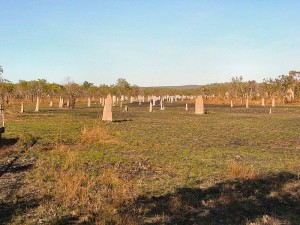 If an alien were to watch a group of human construction workers building a sky scraper without being able to hear them communicate, the alien might make an assumption of self-organization without individual intelligence. Humans build large structures, repair them, and give information to each other constantly. Does this mean humans don’t have individual intelligence or a mind? The fact that we don’t know how termites can build engineering masterpieces, beyond the capacity of human engineering, doesn’t mean the individual termites and colonies are not very intelligent.
If an alien were to watch a group of human construction workers building a sky scraper without being able to hear them communicate, the alien might make an assumption of self-organization without individual intelligence. Humans build large structures, repair them, and give information to each other constantly. Does this mean humans don’t have individual intelligence or a mind? The fact that we don’t know how termites can build engineering masterpieces, beyond the capacity of human engineering, doesn’t mean the individual termites and colonies are not very intelligent.
Where is the leader and the master engineer? Is this an example of mind interacting with the termite?